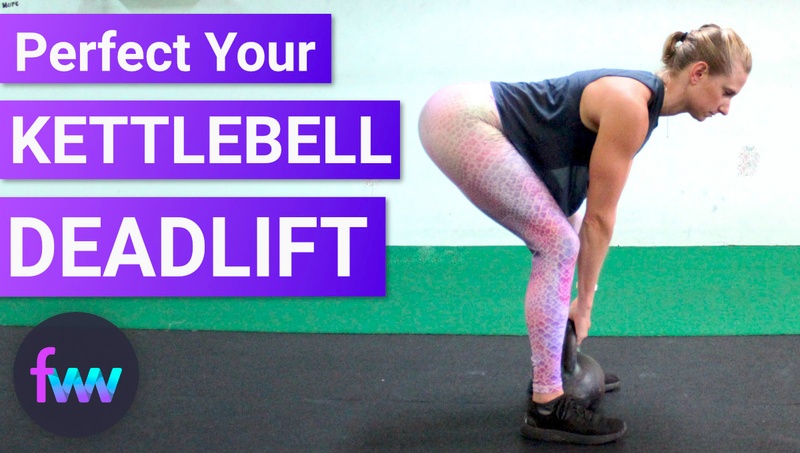The kettlebell deadlift is the first foundational move for nearly all kettlebell exercises.
Why?
The hip hinge.

Nearly all kettlebell exercises revolve around the hip hinge.
Did you know your butt muscles (the glutes) are the biggest muscle complex in the body?
They're also the most powerful.
And deadlifting pairs your hamstrings with your glutes as the primary movers... so deadlifting is a powerful exercise.
Hip Hinge vs Squatting
When you squat... your hips go down towards the ground.
When you hip hinge... your hips go back like you're sticking your butt out as far as possible.
Take a look at these pictures and you can see the difference.



form tip
Notice how my knees are still bent in the hip hinge.
A lot of women think their knees need to be locked out. Don't do this.
When you lock your knees, you disengage your hamstrings and your back becomes a primary mover. Not good... it's how a lot of people tweak their back during deadlifts and kettlebell swings.
Let your knees bend slightly... and make sure your hips (and hamstrings) are going backward!
Notice in both the squat and the hip hinge... your spine is straight.
The Steps To Master Your Kettlebell Deadlift
Step 1: Start Position

I like to put the kettlebell directly between my legs so the handle of the kettlebell is inline with my ankles.
When you stand up straight, it feels like the kettlebell is behind you... but this position really helps you move your hips back.
For the kettlebell deadlift, your feet are hip to should width apart.
Remember your balance throughout the exercise. Balance is foundational to good exercise form. Most form issues happen because of a lack of balance.
Step 2: Hinged Position

Your hips go backward...
Your knees slightly bend to load your hamstrings...
You keep your balance...
Until you're at the bottom. Spine straight... shoulders pulled back.

form tip
Don't lose tension when the kettlebell is on the ground. In other words... don't rest your hands and arms.
You need to keep muscle tension so when you stand up... the kettlebell doesn't pull you out of good form.
I see a lot of women disengage their muscles at the bottom and when stand up... the kettlebell jerks them a little down and this is how you can easily tweak your back.

And this is especially true when you go heavier.
Oh... one more thing.
Make sure you go all the way down to ground. Don't stop short.
And if you're learning...

form tip
If you're new to the deadlift or you already have a really tight back...
Go grab a yoga block.
Put the yoga block between your legs and your kettlebell on the yoga block.
This raises it's height so you don't have to hip hinge as far down to get the kettlebell.
This will save your back and help you find better form.
Over time as you gain mobility... you can go further down.
Step 3: Return to Lock Out

Finally... stand up by thrusting your hips forward.
Don't overcomplicate this too much. If you just stand up naturally... you should be fine but keep in mind it is a hip thrust.
The kettlebell stays between your legs both in the sagittal plane... and coronal plan. In other words... don't let the kettlebell get too far in front of you.
And remember your balance. Your weight should be over your entire foot... don't let it go too far forward or too far backward.

Once you're at the top... lock out!
-
Squeeze your butt.
-
Squeeze your quads.
-
Pull your shoulders back.
-
Hold for a second or two before you go back into the loaded deadlift position.
Make sure not to round the shoulders at the top.

Keep them pulled back by bringing the shoulder blades back and together.
Final Deadlift Tips
There are a lot of different types of deadlifts you can do with kettlebells.
You can even use the deadlift movement pattern as a great warm-up... I call them body weight deadlifts. These are wonderful for warming up your back and hamstrings.
Plus, body weight deadlifts are good for mobility training to get lower when you're really deadlifting.
Commit to mastering this move because it's the gateway to kettlebell swings ... cleans... kettlebell snatches... and so much more!
